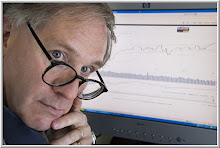 Gold, with its price denominated in U.S. dollars, can be considered a sentiment measure for the dollar. Gold has long been considered a storehouse of value, attractive during times of inflation (falling value of dollar). Some equity sectors also benefit from a weak dollar, including large cap technology, which enjoys multinational sales. As the chart above shows, gold (GLD) and large cap technology (XLK) have both been on the rise over the last few years.
Gold, with its price denominated in U.S. dollars, can be considered a sentiment measure for the dollar. Gold has long been considered a storehouse of value, attractive during times of inflation (falling value of dollar). Some equity sectors also benefit from a weak dollar, including large cap technology, which enjoys multinational sales. As the chart above shows, gold (GLD) and large cap technology (XLK) have both been on the rise over the last few years. Interestingly, the correlation between daily changes in GLD and XLK was only .02 between late 2004 and 2006. During 2007, however, that correlation has been .32.
I decided to take a look at dollar sentiment and its effect on large cap tech by examining five-day changes in GLD and what happens over the next five trading days in XLK.
When gold has been up on a five-day basis (bearish dollar sentiment; N = 408 trading days), the next five days in XLK have averaged a loss of -.09% (214 up, 194 down). When gold has been down on a five-day basis (bullish dollar sentiment; N = 282 trading days), the next five days in XLK have averaged a gain of .58% (179 up, 103 down).
As with my prior post concerning the relationship between price changes in consumer discretionary and consumer staples stocks, it appears that the price of gold is a kind of sentiment measure that may possess some value as a short-term contrary indicator. It's once again an illustration of the interconnectedness of markets across sectors and asset classes.
RELATED POST:
Making a Friend of the Sentiment Trend
.




